
SITF Submissions and Findings
The Species Identification Task Force receives submissions from orchid judging centers or exhibitors.

Coelogyne monilirachis 'Gayle' AM 2025-11-12

Cleisostoma scortechinii 'M&M Orchids' CBR 2025-11-09
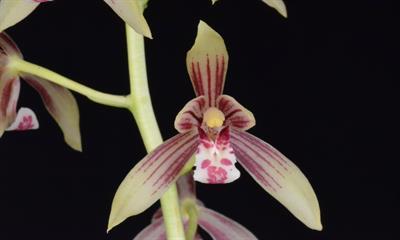
Cymbidium haematodes Seed Studio Rainbow HCC 2025-11-06
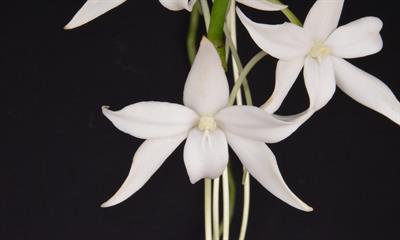
Aerangis modesta 'Chippewa' AM 2025-11-05
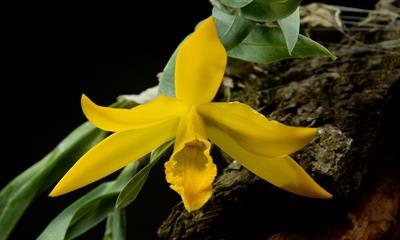
Prosthechea citrina 'Sunshine Sarah Goldberg' AM-CHALLENGE 2025-11-04
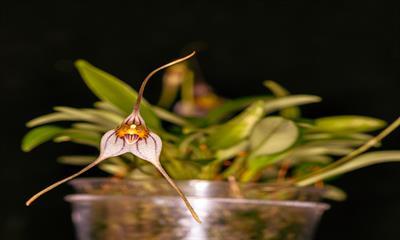
Masdevallia merinoi 'J&L' CHM 2025-11-03

Aerangis pallidiflora 'Alan' CBR 2025-11-03
Barbosella dusenii 'Chandra P' CCE 2025-11-02

Eulophia ugandae 'Powell' CBR 2025-10-25
Finding
SITF confirms this plant as Eulophia ugandae (Nov 2025). A description can be found at https://www.worldfloraonline.org/taxon/wfo-0000254528 for Oeceoclades ugandae (Rolfe) Garay & P.Taylor, which is synonymous with Eulophia ugandae. This plant matches photos of E. ugandae in the orchidroots.com.
Psychopsis sanderae 'Powell' CHM 2025-10-25
Finding
SITF confirms this plant as Psychopsis sanderae (Nov 2025). The column is very distinctive on this species. It matches the column on the flower closeup on the IOSPE website with what looks like osmophores on the ends of numerous stalks. It also matches the flower image of P. sanderae in Joao Almeida's side by side comparison images also shown in the IOSPE.
Pleurothallis (Acianthera) serpentula Bryon CBR 2025-10-25

Brassia andreettae 'Irene' CBR 2025-10-21
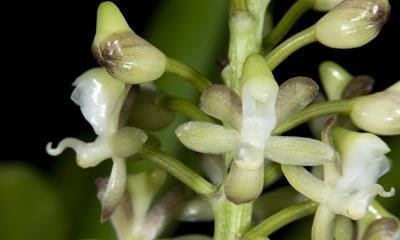
Micropera thailandica 'Irene' CBR 2025-10-21
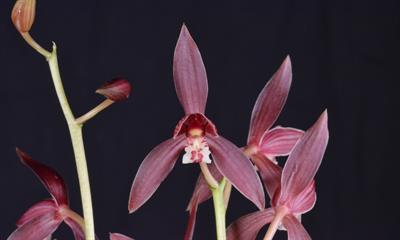
Cymbidium haematodes 'Xi Yang Yang' AM 2025-10-21
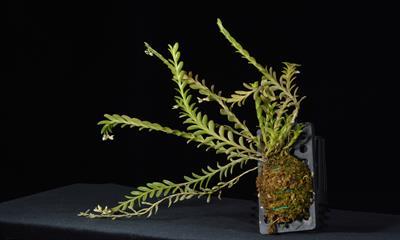
Podochilus khasianus 'Little Weirdos' CBR 2025-10-20

Masdevallia caudata Gigi AM -CHALLENGE 2025-10-17

Lepanthes volador 'Ranga's Hidden Jewel' CBR 2025-10-15

Lepanthes tenuiloba 'Ranga's Jelly Bean' CBR-2025-10-15
Finding
SITF confirms this plant as Lepanthes tenuiloba (Nov 2025). The leaf and flower form and colors are a good match to L. tenuiloba. The drawing and closeup of L. tenuiloba in the IOSPE matches this plant with the form of the leaf tip showing some unusual details. This is a very close match to the images in the orchidroots.com.Lepanthes ejecta 'Little Weirdos' CBR 2025-10-11
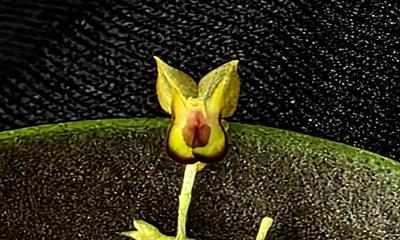
Lepanthes declivis 'Pleurothallidian' CBR-2025-10-11

Podochilus serpyllifolius 'CofO Little Ghost' CBR 2025-10-09
Finding
SITF confirms this plant as Podochilus serpyllifolius (Oct 2025). The flower size, leaf size and the position of the inflorescences match the description of P. serpyllifolius found in Gardens’ Bulletin Singapore 68(1): 87–95. 2016, "New records of Orchidaceae" from Bali, Indonesia". This is the only species that match this plant's leaves and flower shape. P. serpyllifolius and this plant have a very large mentum. The name, serpyllifolius, also refers to the plant looking like Thyme, which also fits this plant.
Bulbophyllum stellatum Bryon CHM 2025-10-09

Lepanthes tamaensis 'Nia' CHM 2025-10-08

Bulbophyllum nitidum 'Very Large' HCC 2025-10-06
Finding
Sitf confirms that this plant is Bulbophyllum nitidum (Oct 2025). This plant is an excellent match to the description and photo in Siegerist's book, "Bulbophyllums and their Allies", pg. 193, plate 61, and to photos in the OW and the IOSPE.
Guarianthe skinneri (Coerulea) 'Jean's Blue Dream' CCM--CHALLENGE 2025-10-05
Finding
SITF has determined this Challenge to Guarianthe skinneri to be Guarianthe hennisiana (Oct 2025) based on the identification by Dr. Wesley Higgins and the Fall (Nov) flowering in the Northern Hemisphere. Another difference, other than flowering season, is that the throat of the lip of G. skinneri is white and that of G. hennisiana below the band of lightly colored tissue (sometimes white, cream or possibly even yellowish) is pigmented.
Guarianthe skinneri (coerulea) 'Orchid Eros' HCC--CHALLENGE 2025-10-05
Finding
SITF has determined this Challenge to Guarianthe skinneri to be Guarianthe hennisiana (Oct 2025) based on the identification by Dr. Wesley Higgins and the Fall (Nov) flowering in the Northern Hemisphere. Another difference, other than flowering season, is that the throat of the lip of G. skinneri is white and that of G. hennisiana below the band of lightly colored tissue (sometimes white, cream or possibly even yellowish) is pigmented.
Cattleya Valentine (1900) 'Barry Paul Mezey' AM--CHALLENGE 2025-10-05

Bipinnula montana 'Bonatto' CBR 2025-09-30
Finding
SITF confirms that this plant is Bipinnula montana (Oct 2025). This plant matches photos in the IOSPE and orchidroots of this interesting and fascinating species. There are other matching photos available on the internet as both B. montana and the synonymous Bipinnula canisii. The lump-like crests at the base of the lip, lip fringe and the fringing of the lateral sepals are a perfect match.
Constantia cristinae 'Marcio Bassi' CBR 2025-09-30
Finding
SITF confirms that this plant is Constantia cristinae (Oct 2025). This plant appears correct based on leaf form and plant habit. The flower photo is not well focused and difficult to see the details; however, the color and flower form matches the flower photo, especially the bright orange callus, and the flower and plant photo in the IOSPE. The flower color seems somewhat variable; refer to the photos in the orchidroots.com.
Isochilus linearis 'Bryon' JC 2025-09-29

FREE ACCESS: Orchid DealWire
Get notified when orchid vendors have special promotions and exclusive savings.







